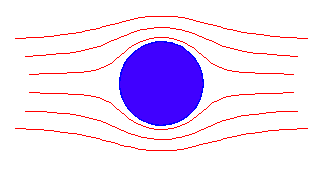Quote:
Originally Posted by kach22i

Aerohead, can you post some visuals on this?
I did find the below, and it is different than the boundary layer I had imagined you were describing.
I imagine that the first layer of boundary air can cause all sorts of drag, lift and vortex formation so we better not ignore it, right?
https://www.google.com/amp/s/www.res...1_30496832/amp |
All cars operate in boundary layer flow ie flow where the viscosity of air is important. So as soon as you see a description of inviscid flow, you know it's purely theoretical (and of course any pressures that are derived from an inviscid flow model are going to be wrong on real cars).
To give you an idea, consider the following diagram of flow around a cylinder:

With non-viscous (ie purely theoretical) flow, the drag is zero! To put this as my father did to me when I was a little kid, to move the cylinder upstream or downstream would take equal force! Clearly, ignoring fluid viscosity isn't a good idea when trying to make aero changes in the real world...